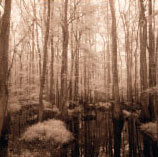TREE TALK
Originally published in Capital on February 14, 2008

The Forest in Sleep Mode?
What's Really Happening in Winter
To express it in computer terminology, the forest is in sleep mode right now, but will soon rouse itself, reboot and get ready to start growing.
But the forest is not in suspended animation during the winter. For trees it’s time for ordinary business; growing roots to get a better foothold in the soil, and finishing the process of forming flower and leaf buds in anticipation of warm and longer days. Small mammals such as squirrels and chipmunks are in their nests sleeping for long stretches, waking up from time to time to eat nuts stored away for just such an moment.
Another group of critters are also taking it easy during the cold winter months. These are the amphibians found in the forests of Maryland. There are several species of tree frogs that make Maryland forests their home as well as a large handful of salamanders, and two toads. Frogs and salamanders rarely make the news, not being poisonous, at least around here, or capable of inflicting a bite. They go about their business routinely, and without much fuss. They breed, lay eggs, the eggs hatch, spend some time in the larval stage, become adults, eat lots of insects, and start the process over again. Not a very enlightened existence but one that seems to work for them just fine. Along the way they provide food for other residents of the forest like snakes, raccoons, skunks, etc. Definitely not the top of the food chain, they do play an important role in the ecology of the forest.
Amphibians are cold blooded like reptiles but have a unique characteristic: their skins are moist; as they at least partly, breathe through their skins, moisture is critical to their survival not only for breathing but also for breeding purposes. During dry spells they will burrow in the soil to stay moist.
During the breeding season, which varies by species, frogs and salamanders head for water where they lay clumps of eggs. In the upland forest there are many areas not close to a stream or pond. Hence, in these areas frogs and salamanders use what are known as vernal pools. Vernal pools, also know as ephemeral pools are temporary wetlands that are created by rainfall or snow melt. They are pretty unique habitats that often contain species of plants that are found no where else. A huge advantage to frogs and salamanders laying eggs in vernal pools is there are no fish in them that could eat the eggs or larvae.
Amphibians in general are being watched closely as there appears to be a sharp decline in their populations worldwide. Not every species appears to be affected but many are. What exactly is causing this decline is not entirely clear. Habitat loss and pollution are the prime and likely suspects, but there are other concerns such as the possibility increased UV radiation due to ozone depletion might be causing mutations in their skin, eyes and even eggs. And there is no practical way to distribute amphibian sun-block, so other ways to solve that problem are needed.
What can the average person do?
Probably the most useful thing is supporting efforts to protect habitat like
riparian areas, wetlands and vernal pools. Especially vernal pools as they are
the most likely to be overlooked. Invasive species are another factor thought
to be part of the decline in amphibians, so diligence in that area is also
needed. In forestry operations maintaining forest buffers and limiting road
building are good standards to hold to. Now it’s a matter of waiting for the
spring peepers to start singing.
For details and photos of the species found in Maryland a good website to visit is the Towson University Herpetology Department at http://wwwnew.towson.edu/herpetology/Amphibians.htm
Questions and comments can be directed to
ForestGreenway@comcast.net
Bud Reaves writes Tree Talk for the Anne Arundel County Forest Conservancy
District Board.
Additional Forestry-Related Links
Champion Trees of Anne Arundel County
Big Tree Champions of Maryland
Native Plants for Anne Arundel County
Planting and Care of Your Trees
TREE-MENDOUS MARYLAND
Invasive Species